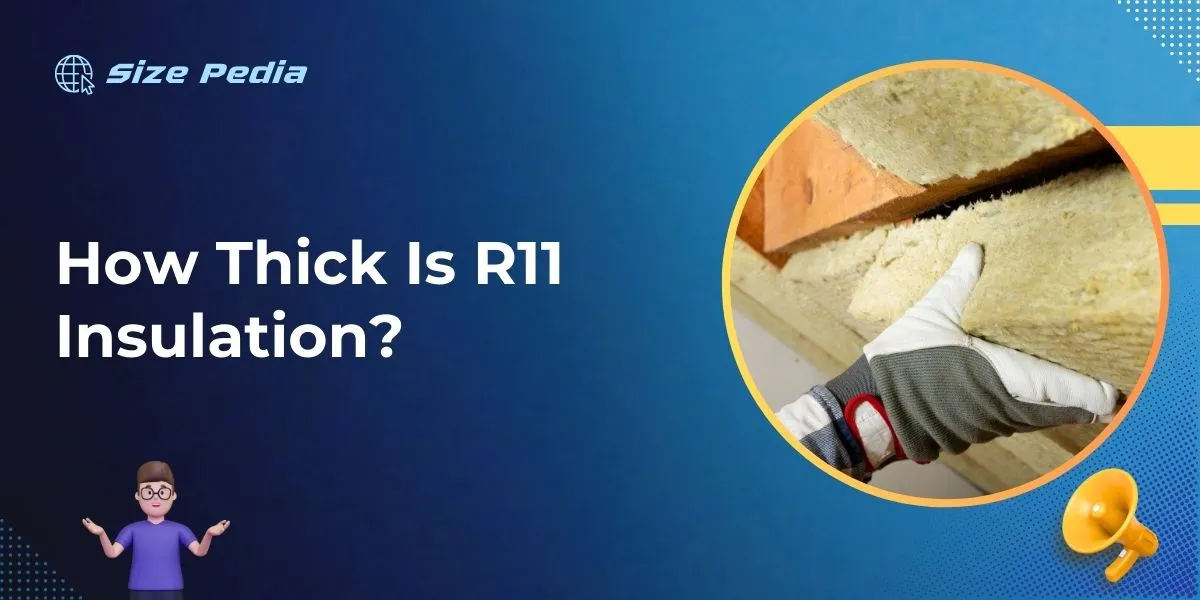R11 insulation typically measures 3.5 inches in thickness. This level of insulation is often used in residential settings.
Ensuring your home is efficiently insulated is crucial for maintaining a comfortable living environment and reducing energy costs. R11 insulation, made from materials such as fiberglass or foam, is specifically designed to fit into standard wall cavities, which are typically 3.
5 inches deep. By choosing R11 insulation, homeowners can enhance their thermal barrier and soundproofing between interior and exterior spaces.
The effectiveness of this insulation type makes it a popular choice for those looking to improve their home’s energy efficiency without excessive renovation.
Selecting the right insulation for your space can lead to immediate and long-term benefits, including lower utility bills and a reduced carbon footprint.

Navigating R11 Insulation
Wondering about the specifics of R11 insulation? This part of the guide simplifies what you need to know when choosing insulation for your home or project. Let’s dive right into the world of R11 insulation and unearth its thickness, applications, and more.
What Is R11 Insulation?
R11 insulation is a thermal barrier commonly found in interior walls. It is part of the R-value system that measures thermal resistance. The higher the R-value, the better the insulation’s ability to retain heat.
R11 is considered a moderate R-value, suited for areas with milder climates or for interior projects where insulation is more about soundproofing than temperature control.
Common Uses Of R11 Insulation
- Internal wall insulation: Keeps room temperatures consistent and reduces noise transfer.
- Basement walls: Used in areas less prone to extreme cold.
- Crawl spaces: Offers a balance between insulation and air flow.
To better understand the application of R11, remember it’s not for freezing climates. Instead, use it to enhance comfort and sound dampening in interior spaces.
Breaking Down The Thickness
Wondering about the specifics of R11 insulation? Let’s dive in and explore its thickness. Understanding insulation thickness helps ensure energy efficiency in homes.
Insulation comes in various ratings, called R-values, to match different climate needs. R11 is one such option, designed for interior walls and spaces where higher R-values might not be necessary.
Standard Measurements Of R11
R11 insulation typically comes in batts or rolls. The standard thickness for this type of insulation is 3.5 inches.
These measurements can vary slightly by manufacturer, but 3.5 inches is the norm. It’s also available in various widths to suit different framing standards, such as 16 inches and 24 inches on center.
Here’s a quick view of the standard sizes:
| Width | Thickness | Length |
| 16 inches | 3.5 inches | Varying lengths |
| 24 inches | 3.5 inches | Varying lengths |
Comparing R11 To Other Insulation Types
Compared to higher R-values, R11 insulation is thinner and less dense. Let’s compare it with a couple of other common insulation types:
- R13 insulation: Slightly thicker at about 3.5 to 4.5 inches.
- R19 insulation: Usually found in floors and attic spaces, has a thickness of about 6.25 inches.
Determining the most suitable insulation type depends on the climate zone and the part of the house you’re insulating.
Material Makeup And Performance

Insulation impacts how warm or cool our homes stay. R11 insulation is one kind that many use in walls.
Its thickness and what it’s made of make a big difference in how it works. Let’s dive into the materials used and how well it keeps in heat.
Materials Used In R11 Insulation
R11 insulation often includes materials like fiberglass or mineral wool. These materials are light but trap air well, which helps control temperature.
- Fiberglass: Fine glass fibers spun together.
- Mineral Wool: Made from rock or steel mill waste.
Thermal Resistance And Efficiency
The thermal resistance, or R-value, tells us how well insulation stops heat flow. R11 insulation has a specific R-value, meaning it has a certain level of efficiency in insulation.
| Insulation Type | Thickness (Inches) | R-Value |
| R11 Fiberglass | 3.5 | 11 |
In simple terms, R11 keeps your room warmer or cooler, based on what you need. It’s not the thickest option, but it works well for interior walls. Remember, the right thickness depends on where you live and your home’s design.
Practical Matters: Installation And Handling
Understanding the correct way to install and handle R11 insulation is vital for effective insulation and safety. This section delves into the practical steps needed for installing R11 insulation along with crucial safety measures.
Installing R11 Insulation
Proper installation is key for maximizing the R11 insulation’s benefits. Follow these points for a smooth installation process:
- Measure the space to determine the amount of insulation needed.
- Cut the insulation material to fit the measurements of the space.
- Fit the insulation snugly between wall studs, ceiling joists, or floor joists.
- Use a staple gun or adhesive to secure the insulation in place.
- Ensure that the vapor barrier faces the correct direction for your climate.
Remember to fill all gaps to prevent air leaks, which significantly reduce efficiency.
Safety Measures During Installation
Safety cannot be overlooked when dealing with insulation materials. Keep these safety tips in mind:
- Wear protective gear: Don safety glasses, gloves, and a dust mask.
- Avoid skin contact: R11 materials can be irritating to the skin.
- Work in a ventilated area: Ensure good airflow to minimize inhalation of fibers.
- Keep the work area clean to prevent slips or trips on loose materials.
- Read material safety data sheets before starting the installation.
By following these precautions, you can install R11 insulation safely and effectively.
Cost And Longevity Concerns
Understanding the cost and longevity of R11 insulation is vital for a smart investment. Many factors affect both initial outlays and potential savings.
Let’s analyze the investment and examine the durability and maintenance required for R11 insulation.
Investment Analysis
R11 insulation is a popular choice due to its cost-effectiveness. An in-depth look at its price requires consideration of several aspects:
- Material costs vary depending on the type of R11 insulation.
- Labor expenses can depend on the complexity of installation.
- Energy savings over time often offset initial costs.
Buyers can expect to recoup their investment through reduced utility bills. The table below outlines estimated costs:
| Insulation Type | Cost per Square Foot |
| Fiberglass Batts | $0.30 – $0.40 |
| Loose-fill Fiberglass | $0.40 – $0.50 |
Durability And Maintenance
The longevity of R11 insulation is another key factor. This insulation is known for:
- Resisting settlement which impacts thermal performance.
- Low maintenance needs due to its material properties.
Proper installation ensures optimal durability. Loose-fill varieties may require occasional check-ups to maintain thickness and performance. Overall, R11 insulation has a lifespan of up to 100 years if maintained correctly.
Eco-impact And Energy Savings

The ‘Eco-Impact and Energy Savings’ of R11 insulation are key aspects when considering home insulation.
R11, commonly used in interior walls, offers both environmental benefits and significant energy cost reductions.
Understanding the thickness of R11 insulation is just the start. Its eco-impact and potential to save on energy bills make it an attractive option for eco-conscious homeowners aiming to improve their home’s energy efficiency.
Environmental Considerations
R11 insulation has several environmental considerations that make it a sustainable choice.
- It reduces the need for excessive heating and cooling.
- This insulation contains recycled materials, lessening waste.
- By improving energy efficiency, it lowers carbon emissions.
- Quality insulation like R11 has a long life span, reducing replacement need.
Savings On Energy Bills
Insulation’s thickness is directly tied to its ability to conserve energy. R11 insulation excels in this area.
| Insulation Type | Thickness | Energy Savings |
| R11 | Approx 3.5 inches | Can significantly reduce heating and cooling costs |
Using R11 insulation can lead to energy bill savings. Households typically notice:
- Decreased need for temperature adjustments.
- Lower monthly utility expenses.
- Enhanced comfort levels within living spaces.
FAQs About How Thick Is R11 Insulation
How Many Inches Is R11 Insulation?
R11 insulation typically measures 3. 5 inches in thickness, designed to fit between standard wall studs.
What Is The Difference Between R11 And R13 Insulation?
R11 and R13 insulation differ mainly in their insulation values. R11 has a lower thermal resistance, suited for interior walls, while R13 provides greater insulation against heat and cold, ideal for exterior walls.
How Thick Is R 13 Insulation?
R-13 insulation typically measures around 3. 5 inches in thickness. This standard size fits snugly between typical wall studs, which are spaced 16 inches apart.
How Thick Is R30 Insulation?
R30 insulation typically measures about 9. 5 inches in thickness. This can provide effective thermal resistance for your home or building project.
Conclusion
Understanding the thickness of R11 insulation is pivotal for any thermal efficiency project. With an average thickness of around 3. 5 inches, it offers a reliable solution for moderate climates.
Ensuring your home is properly insulated with R11 can lead to significant energy savings. Make a smart choice for comfort and cost-effectiveness with this insulation option.
Resources:
1. https://www.energy.gov/sites/prod/files/guide_to_home_insulation.pdf
